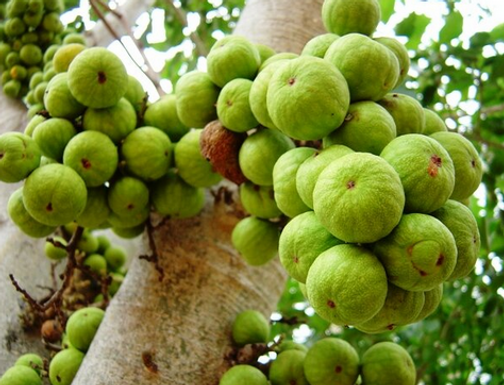Plant identification guides:
Bush tucker food forest
Information about medicinal qualities of plants, or about their use as medicines, is for interest only, and is not intended to be used as a guide for the treatment of medical conditions.
As with all medicinal applications of Australian bush foods, please do your due diligence and consult with First Nations or other Australian herbal specialists before utilising as a remedy for any condition.
Some parts of the plant may not be edible or some may need preparation before they are safe to eat or use in any way. We do our best to describe their traditional & modern uses. It is the reader’s responsibility to ensure they are fit for their intended use.
We can not take any responsibility for any adverse effects from the use of plants. Always seek advice from a professional before using a plant medicinally.
Basic info:
For more information, please see: https://en.wikipedia.org/wiki/Ficus_racemosa
Uses and Interesting Information:
Culinary Uses: The fruit of the cluster fig is edible and is often consumed fresh, dried, or used in various culinary dishes. In some cultures, it is used to make jams and jellies.
Medicinal Uses: Traditional medicine systems utilise various parts of the plant. The leaves and bark are often used in herbal remedies to treat conditions such as diarrhea, dysentery, and respiratory issues.
Cultural Significance: In many cultures, the cluster fig holds religious and cultural significance. It is often associated with fertility and is used in rituals and ceremonies.
Ecological Role: The tree serves as a critical food source for various wildlife species, including birds and insects, which feed on its fruits.
Shade and Ornamental Use: Due to its large canopy, the cluster fig is often planted as a shade tree in parks and gardens. Its aesthetic appeal makes it a popular choice for landscaping.
Interesting Stories About Cluster Fig
Mythological Connections: In Hindu mythology, the cluster fig is often associated with Lord Ganesha, symbolizing abundance and prosperity. It is believed that planting a cluster fig tree can bring blessings to a household.
Historical Significance: The cluster fig has been used in traditional practices for centuries. Ancient texts mention its use in Ayurvedic medicine, showcasing its long-standing importance in health and wellness.
Wildlife Habitat: The cluster fig tree plays a crucial role in the ecosystem. Its fruits attract various bird species, which in turn help in seed dispersal, contributing to the growth of new plants and maintaining biodiversity.
Cultural Festivals: In some regions, festivals are held to celebrate the harvest of cluster figs, where communities come together to share food, stories, and cultural traditions associated with the tree.
Folklore and Legends: Local folklore often includes tales of how the cluster fig tree has provided shelter and sustenance to travelers and wanderers, symbolizing hospitality and nurturing.
Recipes:

